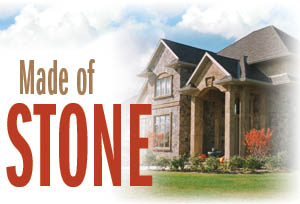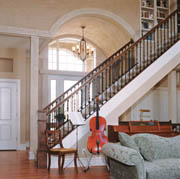
John Loch of Master Drywall and Plaster Inc. can't stop thinking nor talking about a product he's been using more and more of. The Green Bay, Wis., contractor just finished using this material on a 5,000-square foot house in the suburbs of the city and is itching for the next project where his crew can get their chops on more of this material. Customers seeking a typical drywall or plastering job from the company end up demanding that this product be worked into the project. Loch considers the possibilities and says with a little imagination and great skill, this material can accommodate most remodeling needs.
Beginning in the trades at age 14 and starting his own company at 23, Loch has approximately seven jobs going at any given time. With a crew that averages 33 employees, Loch can have as many as 100 subcontractors working for him. He works greater Wisconsin, frequenting areas as far away as Madison and Milwaukee. How has his business grown?
Well, his business like any other has flourished through hard work and aggressive research on what's new in the field. He also has a solid working relationship with at least four builders who keep him busy throughout the state. Most importantly, Loch is a product hound, constantly sniffing around industry publications and trade shows. He proves this by investing in his workers, shipping them off to training sessions to further evolve his company's portfolio and to become more proficient with the latest products.

The wind and the willows
It was by luck that the company was attending one of these sessions in Minneapolis at the distributor Lutz Co. Two of the plasterers from Master had noticed an ArcusStone demonstration and asked about the product. They were then invited by the instructor to come back for a training course and ever since the company can't keep its hands off of it.ArcusStone is based out of Oakland, Calif. It is a field applied stone that can be used with cast stone products, floor tiles or coated foam to create an authentic representation of three-dimensional cut stone surfaces.
"We played around with the product for six months and then put it in our showroom," says Loch. "You have to make mistakes to learn the product and that's what we did."
Leon Church, of Sweetwood Builders, Appleton, Wis., visited Master's showroom, saw the product and wanted the material to be used on the home he was building for himself. Originally, the ArcusStone product was to be used only on the outside veneer of the home, flush against the Cultured Stone that details so much of the home's exterior. Once this work was done, Church was so impressed with the look of the material he asked Master to continue on the inside and "to go nuts with it."
"We combined our work with the Cultured Stone and the theme of stone continues inside on the barrel ceiling," says Loch.
He heard the expression "liquid stone" and agrees that's a perfect description of the ArcusStone line. The material comes out of the bag, is mixed with water and is field applied. As the day progresses, it takes the form of stone and by the end of the day it is rock hard. And it's very easy to apply.
"That's how it came into the barrel ceiling," says Loch. "Could you do this with real stone and block? Yes but it would cost you a fortune. As the product begins to settle, you can shape your own stones."
Since the ceiling in the opening room is 20 feet high, the company ran crown molding half way up. The molding is foam that was cut in Master's shop, coated also with the ArcusStone product. The company has a hot-wire cutter that can cut any profile.

The mighty ducks
In addition to the exterior and the barrel ceiling, the company was also contracted to make a fireplace out of the product, as well as touch up the first floor bathroom. On the barrel ceiling there is a half-arch, so beams and columns were created to complement that feature of the house. The ArcusPlaster line was used."It looks like real stone and appears that it's holding the whole house up," says Loch.
Since the home was built in a rural area with its marshy surroundings and the wildlife landscape of Wisconsin, Master asked to duplicate the outdoor motif inside. On the fireplace, one of the company's more experienced plasterers came up with a sketch and modeled willows and ducks.
Another main highlight in the home was the master bathroom. ArcusStone was used for a stone cap to make it appear that the Kohler SOK tub itself was inserted into a stone enclosure. The ArcusStone floor was also field applied over a wire heating system. But the main draw was the walk-in shower. Both the inside and outside of the shower are completely finished with the Stone Coat finish over lath. A sealer was applied to the finished product to make it water repellant.
Besides the ArcusStone product, basic hawk and trowel tools were used. USG's blueboard was used so the lime coat product could adhere to the substrate easily.
Since the project was completed this autumn, Loch will now begin work on his own home shortly and will also be using the product. The areas he plans to highlight are the arches and columns entering the great room, as well as the fireplace, including stone mantel and crown molding. He is also going with the stone application in the entire master bathroom, walls and shower. In the sunroom, he is going to use the ArcuPlaster to give the entire room an old "cracked" plaster look.
Another product the company has been using is the Synergy wire lath, which he says is working out well in place of blueboard.
"As much as you like a product and as much as you prefer to stay with something, we're always willing to work with new things and this (wire lath) seems to be the Cat's Meow," says Loch.
It is a philosophy such as this that makes Loch a success within the industry. His advice to contractors struggling within their region to keep ahead of the competition is to accept change, try new things and have a showroom displaying the services available. This has generated several leads for him and he believes this will also work for others. He also believes in building relationships with architects, who are thirsty for the latest and greatest products.
"The best advice I have is you really need to work with products in the shop before you take them out to the field," Loch says. "You should make some samples and try different things so you know how they work. There's an old saying in the plastering business, ‘Work the mud, don't let the mud work you.'"


